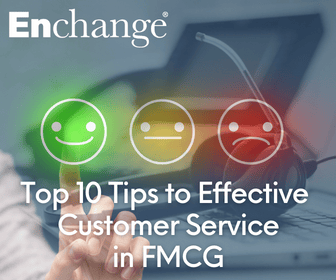The Enchange Supply Chain House; the one-stop shop for all of the elements you need to achieve supply chain excellence.
In a recent article we looked at the Top Tips to make the SC-RtM interface a force for good and not a source of conflict, blame and ultimate disappointment. That SC-RtM interface has a huge impact on Customer Service and how your business is perceived by clients.
Do companies of all sizes deluding themselves on Customer Service? I think some are and may or may not be aware! Whatever service related KPI you measure (assuming you do measure something) the aim is designed to monitor how you are performing both internally and at a retailer or outlet level, against peers. Key Account clients in particular will certainly compare producers and use deficiencies as leverage in negotiations.

Top 10 Tips for effective Customer Service (CS).
1. Measuring CS. There are many ways of measuring CS performance including OTIF, CSLM, CCF and CCFOT amongst many others depending on the local priorities. Essentially you are measuring how much of the right stuff you delivered to the right place at the right time. If you deliver to Key Account logistic platforms you might wish to check at which precise location and time your performance is recorded. Importantly, it is not value based – you might measure that internally for monthly progress reporting but it is irrelevant for service measurement.
2. Relevant Measurement. Service should be measured per SKU thus avoiding the possibility of hiding poor performance at the brand or higher level which is less important. Measuring by SKU allows you to hold the right people accountable and ensure improvement resources are appropriately applied. Measurement at this level allows you to see what is driving your service level.
3. Honest Measurement. Are you measuring against what the customer ordered or what your team said they could supply? This is a common error particularly when order capture is in the hands of employees rewarded via value based incentives, e.g. “that SKU is unavailable but you can have some extra of this”. You need to collect the raw demand from customers to see what they asked for and what they actually received. There is no problem at all with proactive substitution of products with customer agreement as this maintains the relationship and should result in sales. However, this must be a visible process.
4. Fliers/Outliers. The customer may ask for unreasonable amounts of a certain standard or promotional SKU but ignoring or hiding this “data blip” is not the answer. Addressing the issue by establishing some collaborative planning would help both parties. For whatever reason they placed a huge order; find out why and be more ably prepared to potentially service that demand next time.
5. Failure Reason Codes. Use an ERP or other software that automatically allows you to allocate reason codes for service failures and get them investigated promptly. Focus on the big wins using the 80/20 principle, e.g. do not spend too much time finding out why you did not deliver 1 box of washing powder and do spend quality time on the failure to deliver larger volumes of high value beauty products. Both are obviously important but there is a hierarchy.
6. Leadership Buy-in. Ensure your service level and associated discussions are on the agenda of the top table in the company via a KPI or Balanced Scorecard. Your service level reflects every single person in the company and how well you are performing in the market. This means the marketing people, finance team and the HR office and others must be involved. Celebrate successes widely and noisily.
7. CS Leadership. Do you have a Customer Service department led by a talented individual who is graded as highly as peers within the company? CS is a very important function and it should enjoy equality of importance within the business and not be seen as a dead-end role. CS is facilitating the collection of cash after all!
8. Communication. CS is not just about taking orders and printing invoices. Customers deserve the opportunity to talk to or meet with a real human being (avoid answer phones, use Live Chat!) about their problems and concerns. Small issues in invoice accuracy which can delay payment of thousands of Euros can be sorted out by knowledgeable and concerned staff motivated to assist. Occasional face-to-face meetings will undoubtedly build relationships and assist collaboration.
9. Proactivity. Building on communication, perhaps the most important behaviour a CS colleague can possess. Of course, human errors will occur in picking, collating and moving goods but it is what you do when you have advance notice of shortages that defines your service. When you are aware of stock restrictions do you advise your important customers or seek out someone to blame instead? One of the biggest irritations for Key Accounts is only finding out about shortages at the inbound loading bay. A good CS operator can dilute and even negate the customer angst by communicating early and offering solutions.
10. CS Target Setting. Make the CS measure highly visible around the company – everyone should be aware of the overall service their efforts are providing to customers. Don’t fall into the trap of accepting low or ‘sand-bagged’ targets which you are almost certain to achieve as that gets you precisely nowhere. If you are deploying the right processes operated by the right people then success is never guaranteed but it is far more likely.
In simple summary:
Customer Service = Satisfied Customers = Sales = Jobs/Pay/Bonus = Satisfied Staff
Priceless!
Read more articles on Supply Chain Excellence and Route To Market on our website where you can also subscribe to our frequent updates.
Finally, feel free to use any of our contact routes including Live Chat, if you have any questions about how the Enchange Supply Chain House can assist your journey to supply chain excellence.







